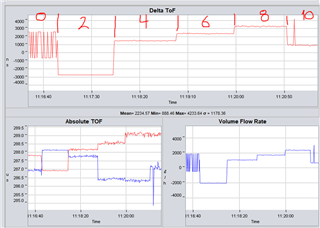We are fighting an issue with spikes in Delta ToF and sometimes in Absolute UPS/DNS. I noticed that our UPS and DNS ADC captures are shifting by more than a full period as we move from our lowest flow to the highest flow rate. In fact, at our highest rate they are shifted by about 1.5x the period of the received ADC capture. I'm wondering if that is fouling up the algorithm resulting in the spikes. Perhaps it is picking the wrong peak when the shift is too great?
Our transducers are 310kHz, so the period is 3.23us. Our full flow range is 10 L/min. The size of the tube results in a shift of about 4.9us @ 10 L/min.



